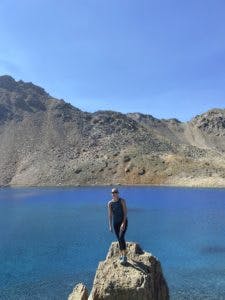COVID-19 Recovery and Return to Physical Activity By: Dr. Laura Wenger, PT, OCS, FAAOMPT
As we move into spring of this year, I can’t help but feel a heavy wave of anxiety and stress when thinking about this past year and the realm of emotions it has brought into my life and the lives of most everyone in the world: uncertainty, fear, and worry to name a few. After speaking with family, friends, and patients, I know that I am not alone. Even with the efficacy of vaccinations and increasing percentages of adults in our community, nation, and world becoming able and willing to have the vaccine, I am still very nervously and hesitantly looking toward days where I don’t have to hyper-analyze nearly every decision made in daily life. Although we are moving slowly and carefully back toward some semblance of “normal”, COVID-19 continues to exist in our community and nation and is still affecting people we know with both new infections as well as some cases of long-term COVID effects, or “Long COVID”.
As more information is gathered about the exact effects of COVID-19 on our bodies, the profession of physical therapy has also been given more guidance on how to help our patients safely return to activity after they have been diagnosed and recovered from the disease. One thing that is evident is that COVID-19 affects surviving individuals in a large variety of ways, from a range of people that don’t have any symptoms present at all to some who feel effects from the disease for months following their active infection. Even for those individuals who have only mild to moderate symptoms and recover quickly with no long-term effects, research currently recommends waiting at least seven days after their symptoms are gone before starting a slow, progressive process of returning to exercise that should take approximately four to five weeks to return to their pre-COVID baseline.(1) Furthermore, for those individuals who experience a more severe case or have any prior history of cardiovascular diseases, specific testing by a cardiologist is recommended in order to return to exercise due to the higher risk of cardiac complications or blood clotting events after COVID.(1) These recommendations are based on the fact that this novel disease is demonstrated to affect all systems in your body, but especially the lungs and heart.(1)

Ultimately, physical therapists and all other health professionals are becoming more equipped to guide patients through post-COVID recovery as more information and data becomes available. As exercise specialists, physical therapists can successfully guide individuals through a progressive program to return back toward their baseline level of fitness after they have recovered from a COVID-19 infection, as long as they have been cleared by their physician. As our community continues to navigate this new world within the existence of COVID-19, I know I’m not the only one who looks forward to seeing more of you out on the trails that we all love to have in our backyard, and I’m looking forward to helping more people get out there safely.
1. Salman D, Vishnubala D, et al. Returning to physical activity after covid-19. BMJ. 2021;372:m4721
